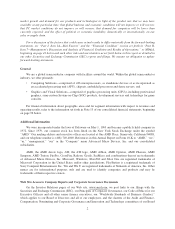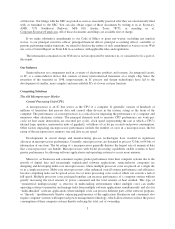AMD 2013 Annual Report Download - page 20
Download and view the complete annual report
Please find page 20 of the 2013 AMD annual report below. You can navigate through the pages in the report by either clicking on the pages listed below, or by using the keyword search tool below to find specific information within the annual report.Competition in the Graphics and Visual Solutions Market
In the graphics and visual solutions market, our competitors include suppliers of discrete graphics,
embedded graphics processors and IGPs. Intel manufactures and sells embedded graphics processors and IGP
chipsets, and is a dominant competitor with respect to this portion of our business. The continued improvement
of the quality of Intel’s integrated graphics, along with higher unit shipments of our APUs, may drive computer
manufacturers to reduce the number of systems they build paired with discrete graphics components, particularly
for notebooks, because they may offer satisfactory graphics performance for most mainstream PC users, at a
lower cost. Intel could take actions that place our discrete GPUs and integrated chipsets at a competitive
disadvantage such as giving one or more of our competitors in the graphics and visual solutions market, such as
Nvidia Corporation, preferential access to its proprietary graphics interface or other useful information.
Other than Intel, our principal competitor in the graphics and visual solutions market is Nvidia. AMD and
Nvidia are the two principal players offering discrete graphics solutions. Other competitors include a number of
smaller companies, which may have greater flexibility to address specific market needs, but less financial
resources to do so, especially as we believe that the growing complexity of visual processors and the associated
research and development costs represent an increasingly higher barrier to entry in this market.
With respect to our game console products, we compete primarily against Nvidia. Other competitors include
Intel, ARM Holdings and Imagination Technology Group.
Research and Development
We focus our research and development activities on improving and enhancing product design. One main
area of focus is on delivering the next generation of products with greater system level integration of the CPU
and GPU and transforming our products into SOCs, with, in each case, improved system performance and
performance-per-watt characteristics. For example, we are focusing on improving the battery life of our
microprocessors and APU products for notebooks and tablets and the power efficiency of our microprocessors
for servers. We are also focusing on delivering a range of low-power integrated platforms to serve key markets,
including commercial clients, mobile computing and gaming and media computing, as well as developing an
HSA, which is designed for software developers to easily program APUs by combining scalar processing on the
CPU with parallel processing on the GPU, all while providing high bandwidth access to memory at low power.
We believe that these integrated platforms will bring customers better time-to-market and increased performance
and energy efficiency. We also work with industry leaders on process technology, software and other functional
intellectual property and we work with others in the industry, public foundations, universities and industry
consortia to conduct early stage research and development.
Our research and development expenses for 2013, 2012 and 2011 were approximately $1.2 billion,
$1.4 billion and $1.5 billion, respectively. For more information, see “Part II, Item 7-Management’s Discussion
and Analysis of Financial Condition and Results of Operations,” or MD&A.
We conduct product and system research and development activities for our products in the United States
with additional design and development engineering teams located in China, Canada, India, Singapore, Taiwan
and Israel.
12
























